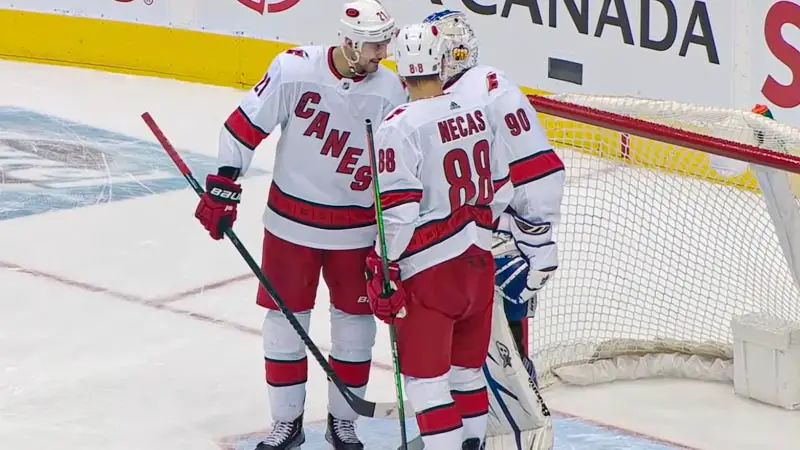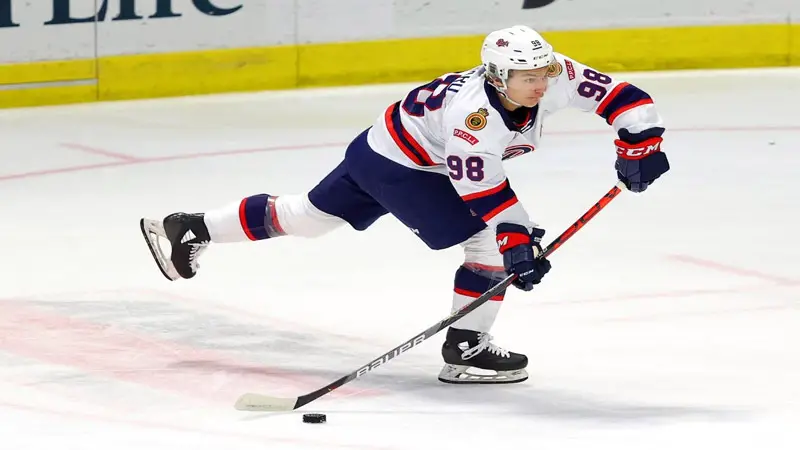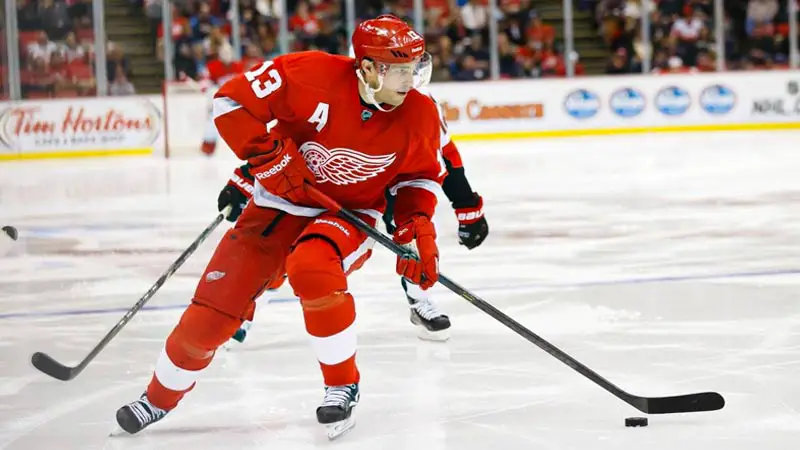Let’s join on a fantasy hockey journey that requires more than just team allegiance; it demands a strategic grasp of the scoring system.
In this exploration, we delve into the nuances of the Fantasy Hockey Point System, deciphering the metrics that shape virtual glory on the ice.
From goals and assists to power-play prowess and defensive contributions, understanding the scoring categories is paramount.
So, stay with us as we navigate the intricacies, offering insights into optimizing player selection, exploiting favorable matchups, and leveraging trade opportunities.
Whether you’re a seasoned fantasy hockey veteran or a newcomer to the virtual rink, this guide aims to sharpen your managerial acumen for a triumphant fantasy season.
What Is Fantasy Hockey?
Fantasy hockey is a simulated sports game where participants, known as fantasy hockey managers, assemble virtual teams of real NHL players.
These managers compete against each other based on the statistical performance of their chosen players in actual NHL games. Points are awarded for various on-ice achievements, such as goals, assists, saves, and other relevant statistics.
Managers draft their teams or participate in auctions before the NHL season begins, making strategic decisions to create a well-balanced roster.
Throughout the season, they can make trades, add or drop players, and adjust lineups to optimize performance.
Fantasy hockey provides fans with an engaging and strategic way to follow the NHL, fostering competition and camaraderie among participants in a virtual hockey league.
Basics of Fantasy Hockey Point System
Fantasy hockey leagues typically use a point system to quantify the on-ice performance of players. The exact scoring system can vary, but here are common elements in a fantasy hockey point system:
- Goals: Players earn points for scoring goals, with additional points often awarded for power-play goals.
- Assists: Points are given for players who contribute assists, helping set up goals for their teammates.
- Plus/Minus: Points or deductions based on the goal differential when a player is on the ice.
- Shots on Goal: Fantasy managers may receive points for the number of shots a player takes.
- Power-Play Points: Additional points for goals or assists that occur during a team’s power play.
- Hits and Blocks: Some leagues award points for physical play, such as hits, and defensive contributions, like blocked shots.
- Goaltender Saves: Goalies typically earn points for saves made during a game.
- Wins and Shutouts: Goalies receive points for wins and, in some cases, additional points for shutouts.
The specific values assigned to each of these actions can vary between fantasy hockey leagues, so participants should familiarize themselves with their league’s scoring rules.
Common Scoring Categories in Fantasy Hockey
In fantasy hockey, scoring categories are used to assign points to players based on their real-world on-ice performance. While scoring systems can vary between leagues, some common categories include:
- Goals (G): Points awarded for each goal scored by a player.
- Assists (A): Points given for each assist a player records.
- Plus/Minus (+/-): Points or deductions based on the goal differential when a player is on the ice.
- Power-Play Points (PPP): Additional points for goals or assists that occur during a team’s power play.
- Shots on Goal (SOG): Points awarded for the number of shots a player takes.
- Hits (HIT): Points for physical play, measuring the number of hits a player delivers.
- Blocked Shots (BLK): Points for defensive contributions, indicating the number of shots a player blocks.
- Goaltender Wins (W): Points awarded to goalies for each game their team wins.
- Goaltender Saves (SV): Points given for the number of saves made by a goalie.
- Goaltender Shutouts (SO): Bonus points for goalies when they prevent the opposing team from scoring in a game.
Fantasy hockey leagues may use different variations and combinations of these categories, and the point values assigned to each category can vary.
It’s essential for fantasy managers to be familiar with their specific league’s scoring rules to make informed decisions when drafting and managing their teams.
Scoring Variations for Each Player Position in Fantasy Hockey

In fantasy hockey, scoring variations for each player’s position are often designed to reflect the unique contributions and responsibilities of different positions on the ice.
Here are common scoring variations for each major player position:
Forwards
Points are typically awarded for goals and assists, reflecting their primary offensive roles. Power-play points may carry additional weight, as forwards often play key roles in power-play situations.
Shots on goal contribute to a forward’s point total, rewarding those who generate scoring opportunities. Plus/minus is a common category, indicating a forward’s impact on the team’s goal differential while on the ice.
Defensemen
Similar to forwards, defensemen earn points for goals and assists, although defensemen tend to score less frequently. Power-play points are significant, as some defensemen play crucial roles in quarterbacking power-play units.
Blocked shots become a valuable statistic for defensemen, reflecting their defensive contributions. Hits might also be a scoring category, emphasizing physical play on the defensive end.
Goaltenders
Goaltenders earn points for wins, making the success of their team a key factor in fantasy performance. Saves contribute to a goalie’s point total, rewarding those who face and stop a high volume of shots.
Shutouts often carry bonus points, recognizing exceptional goaltending performances.
In fantasy hockey, the scoring system aims to capture the diverse contributions of players across different positions.
While forwards are primarily assessed for offensive output, defensemen have additional metrics like blocked shots, and goaltenders are evaluated based on wins, saves, and shutouts.
These variations reflect the distinct roles and responsibilities of each player’s position in the context of a fantasy hockey league.
Strategies for Maximizing Points in Fantasy Hockey

Fantasy hockey success hinges on strategic decision-making to optimize player performance and accumulate maximum points. Here are key strategies to consider:
Player Selection
Draft a well-balanced team, considering players from various positions with diverse skill sets. Prioritize elite players known for consistent point production and multi-category contributions.
Stay Informed
Regularly monitor player news, injuries, and line combinations to make informed roster decisions. Utilize reputable fantasy hockey resources for insights into player performance trends.
Utilize Waiver Wire
Actively manage the waiver wire to acquire emerging players or address position-specific needs. Be vigilant for breakout performances and potential undervalued assets.
Manage Lineups Daily
Adjust lineups daily to capitalize on favorable matchups and account for player injuries or rest days. Utilize players who have a higher chance of excelling based on the opposing teams they face.
Special Teams Impact
Target players who have prominent roles in power-play units, as power-play points often carry significant value. Consider defensemen who contribute offensively, especially on the power play.
Evaluate Schedule Density
Be mindful of teams with a favorable schedule, allowing for more player appearances and scoring opportunities. Plan ahead for weeks with a congested schedule to maximize player utilization.
Diversify Categories
Build a roster that excels in various scoring categories to create resilience against fluctuations in individual player performance.
Balance offensive firepower with defensive contributions to cover multiple fantasy scoring dimensions.
Trade Strategically
Identify and exploit trade opportunities to address positional weaknesses or capitalize on undervalued players. Use trades to enhance overall team balance and capitalize on market inefficiencies.
By incorporating these strategies into your fantasy hockey management approach, you can enhance your team’s competitiveness and position yourself to maximize points throughout the season.
FAQs
How are points typically awarded for goals in fantasy hockey?
In fantasy hockey, points are awarded for goals scored by players. The specific point value varies by league, but it is a fundamental scoring category reflecting a player’s offensive contribution.
Do defensive players contribute to fantasy hockey scoring?
Yes, defensemen are essential in fantasy hockey. They earn points for goals, assists, blocked shots, and hits, making them valuable contributors on both ends of the ice.
What role do goaltenders play in fantasy hockey point systems?
Goaltenders are crucial in fantasy hockey, earning points for wins, saves, and shutouts. Their performance heavily influences a team’s overall point total.
Are there specific strategies for maximizing fantasy points in power-play situations?
Absolutely. Target players with significant roles in power-play units, as power-play points often carry extra weight in fantasy hockey scoring. This strategic focus can enhance your team’s overall point production.
How can fantasy managers adjust for players’ rest days or injuries in their lineups?
Active lineup management is key. Regularly monitor player news and adjust lineups to account for injuries or rest days. Utilize the waiver wire to fill gaps and ensure optimal player utilization.
Wrapping Up
Mastering the Fantasy Hockey Point System is akin to wielding a powerful playbook, and understanding its intricacies is the key to virtual triumph.
The virtual puck may be unpredictable, but your strategic finesse can turn uncertainties into opportunities.
Whether you’re eyeing the championship or aiming to outwit your league rivals, navigating the scoring landscape becomes a journey of strategic brilliance.
With a well-rounded team, shrewd decision-making, and a keen eye on the ever-evolving hockey landscape, your fantasy hockey season transforms into a saga of calculated victories.
May your virtual skaters dazzle, your goalies stand tall, and your point total soar as you chart a course to fantasy hockey glory.








James Felix